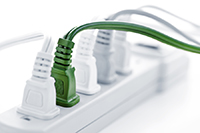Electrotechnology
"Electrotechnology" is a technology that uses electricity to achieve any or all of the following:
- Reduction of total energy usage - Using an infrared oven instead of a gas oven for drying paint on a car will eliminate gas usage. Using an equivalent term to compare electricity and gas usage, it can be seen that less electricity will be required for the process than gas.
- Decrease in waste and pollution output - Using ozone or ultraviolet lighting in a waste stream will reduce or eliminate the pollutants so that the stream can be reused in the facility or be released into public waterways with reduced or no chemical treatment. Sewage costs may be reduced as well as risks for EPA citations.
- Reduction in labor - Injecting ozone into a cooling tower will eliminate the need for personnel to refill chemical solutions to prevent biological fouling.
- Increase in product or process quality - Using radio frequency for drying fabrics allows the product to be dried uniformly, and eliminate the chance for areas of the fabric to become overheated.
- Increase in productivity - Using most electrotechnologies allow for processes to be completed in less time than using an alternate method. Using ultraviolet light to dry ink in a printing process takes less time and allows for multiple color products to be completed in a shorter amount of time.
In most commercial and industrial facilities opportunities exist for the incorporation of electrotechnologies with attractive paybacks once the tangible and intangible benefits of installing an electrotechnology are considered. Electrotechnologies can be retrofitted into an existing building or incorporated into new building designs. Representatives from Northern Virginia Electric Cooperative are available to help evaluate facilities and identify opportunities where an electrotechnology would be an optimum solution.
Some of the more common electrotechnologies and applications include:
- Ozonation - Ozone (O3) attacks and decomposes bacteria and organic compounds in water. The use of Ozone eliminates or reduces the need for chemicals and detergents. Swimming pools, spas, laundry and cooling towers are popular uses for this technology.
- Infrared Drying or Curing - An efficient method of heating because the air in between the source and target is not heated. Electromagnetic radiation is passed from the source (an emitter) to a target. Space heating and curing of paints and coatings are popular uses for this technology.
- Membranes - The type of membrane and fluid pressures can be varied to obtain different concentrations or purity of a fluid. The fluid is forced through the membrane at a high pressure. The most common fluid with applications for this technology is water. Membrane processes are used in the water treatment, pharmaceutical, pulp and paper, and chemical industries.
- Radio Frequency Drying or Heating - This electrotechnology heats a material from the inside out by vibrating molecules of water within the material. The textile, cookie and cracker, gypsum products, and tobacco industries would have ideal applications for this technology.
- Ultraviolet - Water sterilization and curing of inks and adhesives are uses for this technology. Ultraviolet lamps emit light at ultraviolet frequencies. The radiation emitted from these lamps kills bacteria and microorganisms replacing chlorine in water streams, and causes inks and adhesives to bond.
NOVEC staff members are available to:
- Perform building and process surveys
- Recommend electrotechnology improvements to your facility or commercial or industrial process
- Coordinate site visits to see installed electrotechnologies
- Set up meetings with experienced electrotechnogy vendors
Contact NOVEC's Business Development Division at 703-392-1604 or 703-392-1763, extension 1604 or 1763, or via e-mail at [email protected].


